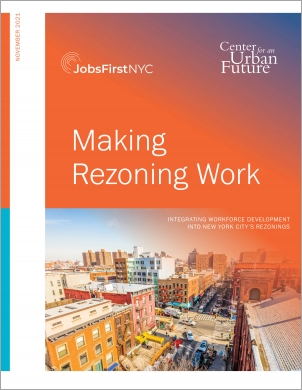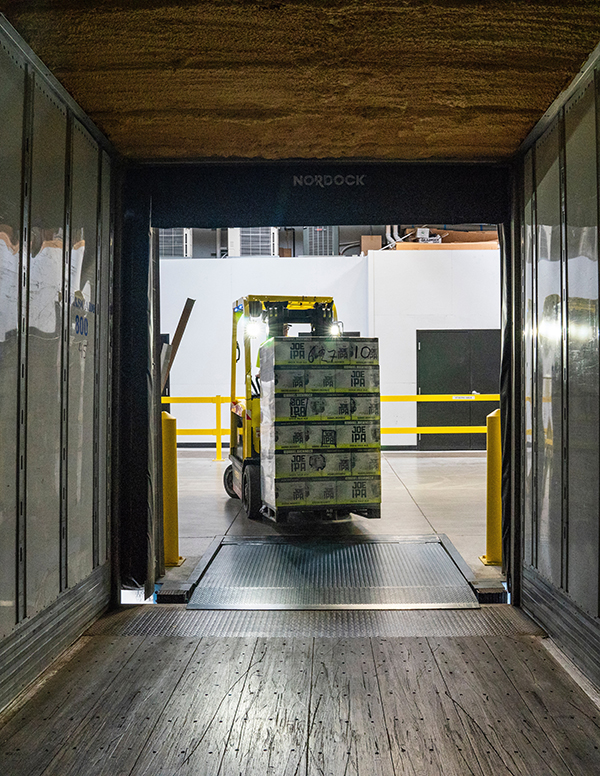As New York City grapples with a protracted economic crisis brought on by COVID-19, city leaders will be searching for opportunities to help spark a lasting economic rebound and regain many of the nearly 500,000 jobs lost since March 2020. One option is to use zoning tools to encourage economic development, attracting private investment at a time when public funding is extremely limited and helping to revive the city’s battered economy.
But to earn the trust of communities that have been hit hardest by the pandemic—and ensure that new development benefits the New Yorkers most in need of economic opportunities—New York City will need to develop a bold new vision for building workforce development infrastructure at the neighborhood level.
Since 2016, communities across New York City, from East New York to Inwood, have undergone large-scale residential rezoning. Designed to encourage the construction of affordable housing, neighborhood rezoning plans have nonetheless sparked understandable fears that new development enabled by land-use changes will lead to gentrification and displacement. The de Blasio administration has responded to these concerns by tying housing protections and other investments to neighborhood rezoning plans. However, thus far, the rezoning plans have lacked investment and accountability around local workforce development.
The need for these investments is clear: In the six neighborhoods which have already been rezoned, median household income is nearly $17,000 below the city average. More than a year into the COVID-19 pandemic, the estimated unemployment rate in East Harlem is upward of 20 percent and nearly 30 percent along Jerome Avenue in the Bronx. For many residents of these neighborhoods—and many others throughout the city—obtaining a living-wage job in an eventual economic recovery is made harder without access to quality workforce development services.
While recent rezoning plans have included numerous commitments—from housing protections for current renters to new community spaces and playgrounds—workforce investments have been minimal. According to its commitment trackers, the city budgeted just $462,250 for job training initiatives focused on just two of the six residential neighborhoods approved for rezoning since 2016. Just $312,500 had been spent on new job training programs as of June 2021.
A more deliberate approach is needed: one that provides communities with a blueprint for establishing and strengthening neighborhood-level workforce networks, taps private sector dollars to invest in meeting workforce needs, builds the capacity of training providers to serve more residents, scales up the most effective workforce programs from across the city, and incentivizes partnership and collaboration. This report examines the current role of workforce investments in the city’s recent and ongoing neighborhood rezoning plans and charts a path for city policymakers, workforce practitioners, philanthropic leaders, and local community-based organizations and business leaders to support a new model for place-based workforce investment that can help expand economic opportunity in the communities that need it most.
This report—a joint effort between the Center for an Urban Future and JobsFirstNYC—demonstrates the need to integrate a comprehensive workforce development strategy into future rezonings and offers a blueprint for how to do so. Informed by more than 50 interviews with workforce development practitioners, community leaders, city officials, nonprofit executives, and economic development experts—as well as analysis of data on economic and workforce conditions, city reports, budget documents, and other information—the report identifies effective models for place-based workforce development in and outside New York, examines obstacles to integrating workforce development investments into rezoning plans, and lays out a set of practical and actionable recommendations to integrate community-focused skills-building and workforce development investments into rezoning efforts—now and in the future.
Many New York City neighborhoods face serious barriers to employment, but investments in workforce development have not kept pace.
In order to help more New Yorkers participate in the city’s emerging economic recovery from the COVID-19 pandemic, neighborhoods from the South Bronx to the north shore of Staten Island will need help tackling pervasive barriers to employment, including boosting skills to meet the demands of a fast-changing economy. The need is clear: While New Yorkers have seen a proliferation of low-wage jobs in recent years and a growing need for job training and skills-building to access better-paying work, there’s been relatively little new funding for workforce development. Federal funding for workforce development in New York City has dropped from $87.1 million in 2001 to $74.5 million in 2020—a 14.5 percent decline, adjusting for inflation—and state and local funding has struggled to make up the difference.
After reaching its highest level of employment on record in 2019, New York City’s economy has been battered by COVID-19. The steepest job losses have been clustered in many of the city’s lowest-income communities and in industries with a large share of the city’s accessible jobs. As of June 2021, employment in restaurants and bars remains 34 percent below the pre-pandemic level. Employment is down 64 percent in accommodations, 24 percent in clothing stores, 17 percent in building services, and 19 percent in manufacturing. And while most of the city’s office sectors have held up much better—for instance, jobs in the information sector are down just 3.5 percent— far fewer of those jobs are held by New Yorkers without college degrees or other postsecondary credentials.
For too many New Yorkers, jobs in the industries that are proving more resilient to the current crisis— and are likely best positioned to lead an economic re- bound—remain out of reach. Most of New York City’s growing occupations that pay middle-income wages or higher, from registered nurses to marketing specialists, typically require at least some form of postsecondary credential. But access to these jobs remains sharply divided by geography: for instance, while 86 percent of Upper East Side residents hold at least a bachelor’s degree, the rate is just 13 percent in Mount Hope. Indeed, 19 percent of New Yorkers over twenty-five—over 1.1 million people—do not hold a high school diploma or its equivalent. Even more New Yorkers—1.8 million people, or 23 percent of the population—have limited English proficiency, locking them out of many opportunities to take part in the city’s economic rebound.
The result is that economic mobility and success vary dramatically from neighborhood to neighborhood, with harsh consequences from the pandemic-driven economic downturn. From a citywide unemployment rate of 4.3 percent in July 2019, among the lowest on record, unemployment surged to 29 percent in West Farms and 36 percent in Brownsville as of December 2020. An estimated 259,000 (27 percent) to 324,000 (34 percent) of 16- to 24-year-olds across New York City are out of school and out of work—more than double the rate in 2019.
Many of those disparities are particularly acute in neighborhoods that have been rezoned or where rezonings are under consideration. For instance, over 38 percent of Inwood residents speak English less than very well. In Sunset Park, more than 46 percent of adults lack a high school diploma. And in East New York, fewer than 15 percent of adults have a bachelor’s degree.1 These barriers mean that even when jobs are available, neighborhood residents don’t necessarily have the tools to get them. “There are these big sectors in East New York that have living-wage jobs, but we need investments in the training to get more people into the jobs,” says Michelle Neugebauer, executive director at the East New York-based nonprofit Cypress Hills Local Development Corporation (CHLDC).
Neighborhood-level rezonings present a vital—but largely untapped—opportunity to make crucial investments in workforce development.
Across dozens of interviews with workforce development practitioners, community-based organizations, local employers, economic development officials, and other experts—alongside an extensive review of available data—a clear pattern emerged: neighborhood rezoning initiatives present an important but undervalued opportunity to combat these significant barriers to economic access through intensive and early integration of workforce development investments.
“Workforce investments should absolutely be included in the rezoning plans—workforce development, adult education, and bridge programming,” says Michelle de la Uz, executive director of Fifth Avenue Committee and a member of the City Planning Commission. “We absolutely need to raise wages and household income for people that are unemployed or underemployed, or whose jobs are at risk of displacement either because of a rezoning or just because of trends in the economy. It takes a multiyear funding commitment at a scale that’s necessary to address whatever the gaps are locally.”
For many years, the city’s approach to workforce development—like much of the nation’s—was largely focused on rapid attachment to any available job. In more recent years, the approach has evolved to emphasize both sector- and place-based models that align training programs with employer demand along defined career paths; integrate workforce development programs into economic development initiatives; and stitch together skills-building programs across education and job training providers to better reflect industry demand for both hard and soft skills.
But as New York City’s workforce development needs explode amid a protracted economic crisis, the city faces a major challenge—and an opportunity—to design and implement new and strengthened place-based approaches. There are multiple benefits to these approaches, which can both prepare local residents to access new jobs that are being created as a result of economic development in the community and boost the skills needed to access well-paying jobs elsewhere in the city—increasing household incomes as a way of helping people remain rooted in their communities even as neighborhoods undergo changes.
“New York City has an enormous opportunity to in- vest in workforce development through its neighborhood rezonings,” says Katy Gaul-Stigge, president and CEO of Goodwill Industries of Greater New York and Northern New Jersey and the former executive director of the Mayor’s Office of Workforce Development. “The city’s approach shouldn’t be limited to connecting local residents to temporary construction jobs—it should include place-based strategies and targeted investments in skills-training that ensure residents of rezoned neighborhoods can access permanent good jobs throughout the city, and the rezoning lives up to its promise of truly improving life for all in the neighborhood.”
With a more intentional rezoning process, New York could make significant new investments in place-based strategies to help spur an inclusive economic recovery.
Place-based workforce development focuses investments on the areas with the greatest barriers to economic access—like the neighborhoods being rezoned—by bringing resources directly to the people who have the most to gain from education and training programs catered to local needs. “The city has an opportunity to be in the forefront of a lot of the experiment and change in workforce development,” says Ben Margolis, executive director of Southwest Brooklyn Industrial Development Corporation. “Rezonings, which by definition are places of concentrated public investment, are logical places where workforce investments at the forefront of the field can and should take place.”
Place-based approaches are attuned to economic and social realities in individual neighborhoods while still responding to employer needs. And they can provide support to the most precarious, who might have fallen through the cracks in other systems. “The value of place-based approaches is that particularly for more vulnerable job seekers, the support systems they need to be successful are generally located closer to home,” says Christopher Watler, chief external affairs officer at the Center for Employment Opportunities (CEO), a national workforce development organization that supports employment opportunities for formerly incarcerated people.
Workforce development has great potential to act as a hedge against displacement by providing education and skills-building that can lead to quality job opportunities and life-long economic stability. “This is the opportunity to bridge workforce development with economic development in this city,” says Sunil Gupta, vice president of adult and continuing education at LaGuardia Community College. “Under the guidance of the city, a lot of good things can happen.”
But harnessing that potential will require a new strategy to build and strengthen place-based workforce networks and harness the opportunity that rezoning presents to tap private dollars for sustained investment in skills-building and job training infrastructure.
Although the rezoning process has led to numerous community commitments, workforce investments have been lacking.
When the city proposes a neighborhood rezoning, it develops a series of commitments tied to land-use changes. These commitments revolve around housing protections but also include investments in infrastructure, schools, parks, and small business services. But our research finds that substantial investments in workforce development have been all but nonexistent in approved rezonings.
According to its commitment trackers, the city budgeted no more than $462,500 for job training initiatives across all six neighborhoods approved for rezoning to date, of which no more than $312,500 had been spent as of June 2020. These six rezonings resulted in more than 320 specific commitments ranging from public transit improvements to rental assistance programs. But just 33 of those commitments were focused on workforce-related issues, and only seven included specific budget amounts.
In East New York, the first neighborhood rezoned under the current administration, the city committed to a new Workforce1 Career Center—a hub for jobseekers operated by the Department of Small Business Services— but did not make any specific investments in job training or skills building. In the fifth rezoned neighborhood, Inwood, the city created a new Career and Technical Education program at a local high school but included no new funding for adult programs as part of its plans. In fact, of the six neighborhood rezonings approved under the de Blasio administration so far, three have not included any investments in worker training: East New York, Far Rockaway, and Bay Street.
Without a blueprint to prioritize and design neighborhood-level investments in workforce development infrastructure, the years-long rezoning process— including eight months or more in the formal uniform land use review process (ULURP) and years of community discussions—has failed to deliver on this vital opportunity. “When it came to the final negotiation, it was really all about the housing,” says Michelle Neugebauer of Cypress Hills LDC. “The other things the community wanted and needed, the second priority being living-wage jobs and economic development, really took a backseat.”
Workforce needs, local job opportunities, and the capacity of community-based organizations vary significantly by neighborhood, requiring a flexible and intensive approach.
Building job readiness and knocking down barriers to employment for residents of neighborhoods undergo- ing rezoning requires a flexible approach to place-based workforce development. Zoning changes can unlock new economic activity that will lead to job creation— a crucial need as the city reels from months of unprecedented job losses—but identifying emerging job opportunities by networking with employers and building local capacity to prepare residents for them should begin long before a rezoning occurs. An inclusive approach to local workforce investment will require long-term investment in boosting educational attainment; support for bridge programs that can provide onramps to further education and training for New Yorkers with limited English proficiency or who lack digital skills; and partnerships that integrate—and fund—wraparound supports like mental health services and childcare with skills development and job training.
To lay the groundwork for this approach, city leaders should work with community partners to map the current ecosystem of trusted, community-based institutions—including training and social services providers, community colleges, place-based intermediaries, and local employers—in neighborhoods poised for new development, and create neighborhood-specific plans to strengthen existing talent development infrastructure and replicate effective models to close gaps.
Our research has identified several promising strategies both in and outside of New York that together yield a set of best practices New York City can look to in the future. In downtown Manhattan, LESEN provides a model for how local organizations focused on business outreach, together with social services and job training providers, can join forces to generate access to job opportunities spurred by new development. Outside of New York, cities such as Philadelphia have pioneered programs that partner with large employers to develop training programs. Others like Boston passed changes to zoning law requiring all developments of a certain scale to contribute funding for education and training.
New York City has a clear opportunity to integrate workforce development into future neighborhood rezonings, but significant obstacles remain. The next mayor should launch a comprehensive neighborhood-based workforce development strategy to build and strengthen local hiring and training networks and coordinate investments across agencies—long before proposing any rezonings. The city should proactively develop a local workforce network in every neighborhood with a poverty or unemployment rate higher than the city average, whether or not a rezoning is imminent, and
To pay for these crucial investments, the next mayor and City Council can establish citywide linkage fees—modeled on Boston’s successful Neighborhood Jobs Trust initiative—which would add a small fee on new market-rate developments over a minimum number of square feet and use the proceeds to create an education and training fund for neighborhoods undergoing rezoning. Coupled with other city investments, these new initiatives should include expanding place-based approaches to develop strong local networks, building the capacity of local organizations, scaling effective programs to serve new communities, and connecting residents of rezoned neighborhoods to skills-building, education, and job placement opportunities across the city.






